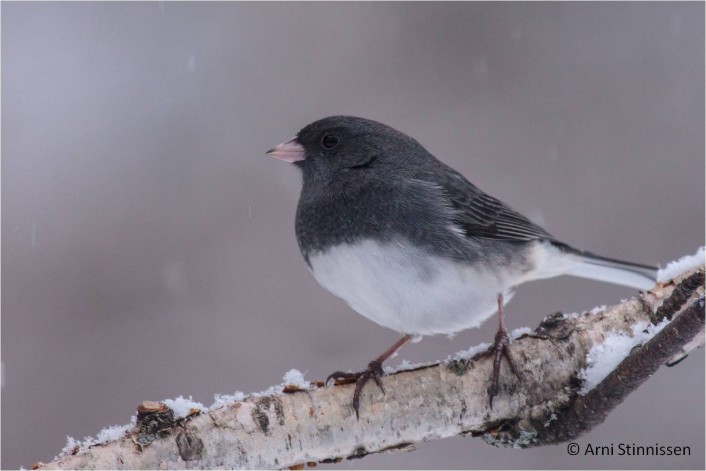A member of the sparrow family of birds, the Dark-eyed Junco is a familiar sight at our bird feeders every fall and spring. In some locations they may even spend the entire winter in our region. Although there are a number of subspecies of Juncos, the Slate-coloured is the only Junco east of the Rockies. Males have a slate-coloured back and upper breast, the belly feathers and the two outer tail feathers are white. The small bill is horn-coloured. Females are much duller in colour. They tend to be a little leaner and more streamlined than other members of the sparrow family.
Preferring nesting areas north of us, flocks of 20-25 birds will form and forage together come late fall, and will migrate as far south as necessary in order to find food. Males dominate the females and therefore make claim to much of the food, so females tend to migrate farther south than the males. Young males stay closer to home and do not migrate long distances, which gives them a head start in locating a breeding territory come spring. Older males are not so concerned about getting back to the breeding grounds early as they have already laid claim to their patch and will fend off young male birds.
When the females return, couples are formed and the monogamous pair will stay close to each other. The female will build a cup-shaped nest near the ground in grasses or shrubs into which she will lay four or five white, speckled eggs which she alone will incubate for 10-12 days. Young are fed by both parents until they are three to four weeks old. The pair will have two or sometimes three broods during the breeding season.
Dark-eyed Juncos prefer habitat near forest edges with lots of ground cover, where they forage for insects in the summer months and seeds during the winter. When seed heads are formed on tall plants, Juncos will fly to the top of the plant and then ride the seed cluster down to the ground, where their weight will hold the cluster on the ground while the bird picks off the seeds.
If you have feeders in your yard, Dark-eyed Juncos can be found at the base of feeders scavenging seeds. They prefer locations where they can easily take refuge in nearby bushes, hedges and shrubs to escape predators. Watch for the flash of white from the outer tail feathers as they fly to take cover. They won’t stay hidden for long though, soon they will re appear, hopping from under the bottom branches, scratching the grass between fallen leaves in search of more food. Dark-eyed Juncos, delightful additions to the other ground feeding species during the rather dull, late fall days.
Written by David A. Homer.

